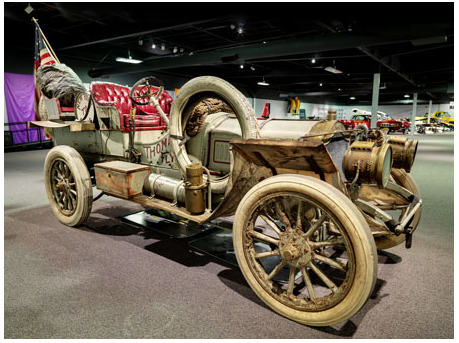Colors have never been richer at the National Automobile Museum (The Harrah Collection) in Reno, Nev., and it has enthusiasts seeing vintage cars in a new light. Following the installation of more than 600 GE energy smart® LED replacement lamps, patrons are remarking on a "remarkable difference" and the museum is enjoying $18,000 in annual electricity savings as the result of its environmentally intelligent investment.
When National Automobile Museum opened in 1989, it was reported to have set new standards for automotive exhibits with its extensive collection and dramatic displays. Recently named one of 'America's Five Greatest Automobile Museums' by AutoWeek magazine, it features more than 200 cars, the majority from the world-famous collection of the late gaming pioneer, Bill Harrah. In August 2011, 635 90-watt standard lamps in four galleries were replaced with an equal number of GE 17-watt PAR38 LEDs. Museum management, working with the Business Environmental Program (BEP) at The University of Nevada, Reno, to identify areas to conserve energy, had efficiency in mind, and didn't mind sacrificing lighting quality to achieve it - or so they thought.
"I felt that when we entered into this project, because of the significance of the energy savings, that we would be compromising the quality of lighting in the museum, and we were prepared to make those adjustments," says Jackie Frady, executive director for National Automobile Museum. "That was the expectation, and we were so surprised to find that the end product far exceeds the quality of the lighting we had."

The National Automobile Museum in Reno, NV recently installed over 600 GE energy smart® LED lamps.
The lensed design of GE's PAR38 LEDs made the difference when the displays were illuminated. Exposed LEDs would have been visible in the cars' paint, a distraction to the museum's more than 65,000 annual visitors. Instead, GE's LEDs diffused the light evenly and outperformed the 90-watt lamps they replaced.
"Now the collection just comes to life," says Frady. "The paint colors are more striking on the vehicles. There's also a new vibrancy in the galleries. A few people who are very familiar with the museum have come in just to see the lighting, and I heard back from them saying, 'What a great project, what a difference!'"
The new LEDs are making a difference in utility and maintenance expense as well. National Automobile Museum will save $18,000 (nearly $30 per fixture) this year in electricity costs alone. Including reduced lamp maintenance and replacement, annual savings will approach $30,000. Instead of changing each light every year, a task requiring between two and five hours a week, the LEDs will last between three and five years based on the museum's hours of operation.
Project payback, based on energy savings alone, will be achieved in approximately 17 months.
"Lighting is a key opportunity for lower energy use for businesses," says Peter Millar, the BEP energy management specialist who steered the museum to new energy-efficient practices including re-lamping. Established in 2006, the BEP provides free and confidential environmental management assistance to commercial and business operations in Nevada.
"Lighting can represent up to 40 percent of your energy consumption depending on your type of operation. Among all energy-efficient improvements, lighting has perhaps the highest return-on-investment potential in most cases," notes Millar.
GE energy smart® LED replacement lamps use an electronic chip (not a superheated filament) to produce more light with less power versus comparable incandescent bulbs. They also generate less heat and could, depending upon the particular environment, bring additional HVAC savings. Solid-state construction means no moving parts and no filaments to burn out. Sturdy and dependable, some are rated up to 50,000 hours of life, depending on the lamp.
"Particularly for nonprofit businesses, we need to save money, and the fact that this project has brought forth such a significant savings makes it worth it," says Frady. "And then when you have that extra benefit of improving your product or environment, you just can't beat it."












